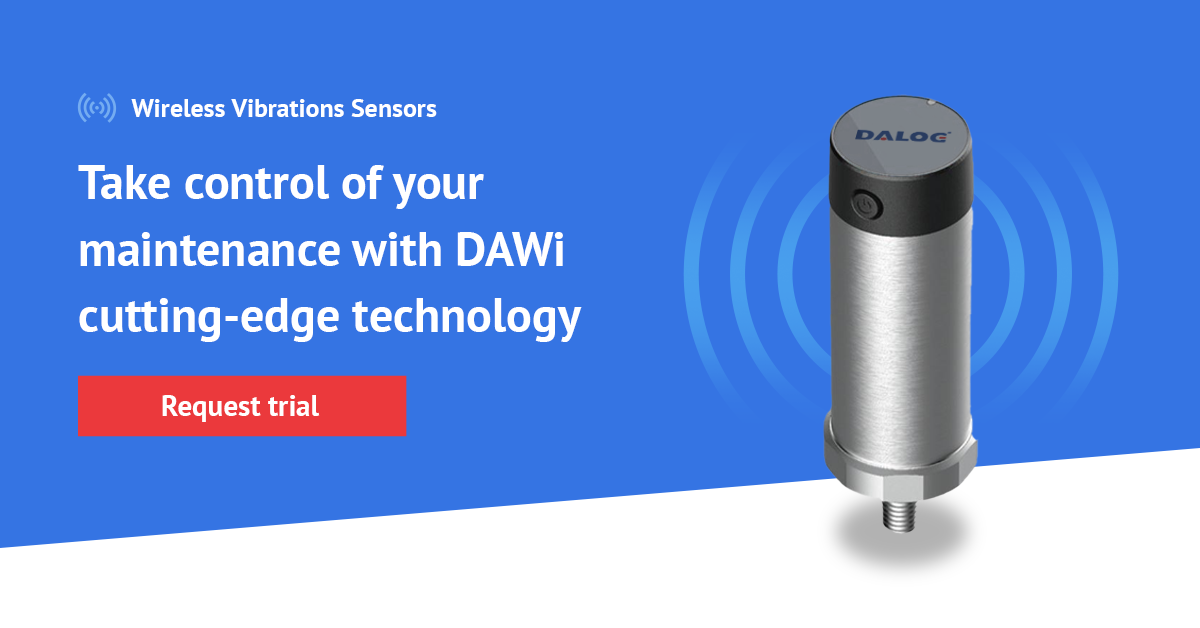What Are Wireless Vibration Sensors, and How to Connect Them
In today's fast-paced and competitive business environment, ensuring the reliability and longevity of critical machinery and equipment is of utmost importance. Unplanned downtime can result in costly repairs, decreased production and revenue, and in some cases, even safety hazards.
That's where the importance of predictive and proactive maintenance comes in, and wireless vibration sensors play a crucial role.
Wireless vibration sensors are small, battery-powered devices equipped with accelerometers that measure the amount of vibration or movement produced by machinery and equipment. The data collected by these sensors is then transmitted wirelessly to a monitoring system, which can be analyzed and used to detect potential problems before they become serious.
This allows maintenance personnel to address the issue and prevent downtime, ensuring equipment reliability and longevity.
In this article, we will explore the differences between wireless and wired vibration sensors, the functions and benefits of wireless vibration sensors, how to connect them to a monitoring system, and several real-life examples of their applications.
- What do Vibrations Sensors Measure?
- Wireless vs. Wired Vibrations Sensors
- What are Wireless Vibration Sensors?
- Real-Life Examples of Wireless Vibration Sensors
- Connecting Wireless Vibration Sensors to a Monitoring System
What do Vibration Sensors Measure?
Vibration sensors measure the motion and frequency of vibration in a specific location on machinery and equipment. These sensors are designed to detect and analyze the movement of the equipment, providing valuable information about its health and performance.
Vibration sensors measure several vital parameters, including:
Frequency: Vibration frequency is the number of complete motion cycles in a specific time. Frequency is measured in hertz (Hz) and is an important indicator of the health and performance of equipment.
Amplitude: Amplitude is the measure of the maximum displacement of the vibration. This is an important parameter as it indicates the strength of the vibration and the potential damage it may cause.
Velocity: Velocity measures the speed at which the vibration moves. This parameter determines the equipment's overall health and identifies potential problems.
Displacement: Displacement measures the distance the vibration moves from its original position. This parameter determines the equipment's overall health and identifies potential problems.
Acceleration: Acceleration is the measure of the rate of change in the velocity of the vibration. This parameter determines the equipment's overall health and identifies potential problems.
Sensitivity: Sensitivity refers to the ability of the vibration sensor to measure the vibration levels accurately. This is an important parameter as it ensures the accuracy of the data collected.
Severity: Severity is the measure of the impact of the vibration on the equipment. This parameter determines the potential for damage and the need for maintenance.In addition to these parameters, some vibration sensors may also measure additional parameters, such as temperature or humidity. This information can be used to identify correlations between the environment and the vibration levels in the equipment.
Vibration sensors provide valuable information about the health and performance of equipment. Businesses can identify potential problems early by measuring these parameters, reducing downtime, and increasing efficiency. Additionally, regular monitoring and maintenance can extend the life of the equipment and improve its overall performance.
Wireless vs. Wired Vibration Sensors
Before diving into the specifics of wireless vibration sensors, it's essential to understand the differences between wireless and wired vibration sensors.
Wired vibration sensors are connected to the monitoring system through a physical connection, such as a cable, while wireless vibration sensors use a wireless network to transmit data.
Wired vibration sensors have been around for a long time and are still widely used today. They are cost-effective and have lower latency, providing faster and more accurate readings. However, they are more limited in terms of installation, as they require a physical connection to the monitoring system. This can be inconvenient and expensive, mainly if the equipment is located in remote areas or hard-to-reach locations.
Wireless vibration sensors, on the other hand, offer greater flexibility in terms of installation, as they don't require a physical connection to the monitoring system. They are easy to install and can be placed anywhere without the need for any wiring or cabling. This makes them ideal for use in remote locations or monitoring equipment in difficult-to-reach areas.
Download and learn more about wireless vibration sensors from The Reliability Manager’s Plan: How to Choose the Most Cost-Effective Solution for Predictive Maintenance
What are Wireless Vibration Sensors?
Wireless vibration sensors are small, wireless devices that detect and measure vibrations in machinery and equipment. These sensors work by analyzing the motion and frequency of vibration in a specific location and transmitting this data to a monitoring system.
Wireless vibration sensors monitor equipment's health and performance, helping businesses identify potential problems before they become serious. This allows for proactive maintenance, reducing downtime, and increasing efficiency.
The benefits of using wireless vibration sensors include:
- Real-time monitoring of equipment
- Early detection of potential problems
- Increased equipment efficiency and reliability
- Decreased downtime and repair costs
- Improved safety
When choosing wireless vibration sensors for your company, it's important to consider the following factors:
Type of Equipment: Different types of equipment will require different sensors. For example, large, heavy equipment may require more robust sensors that can withstand high vibration levels, while smaller, lighter equipment may only require basic sensors.
Environment: The environment in which the sensors will be used is also important. For example, sensors used in harsh, industrial environments must be rugged and weather-resistant, while sensors used in more controlled environments will not require such protection.
Data Collection and Analysis: The monitoring system you choose will also be essential to consider. Make sure that the system you choose can collect and analyze the data from your sensors and provide real-time monitoring and alerts if necessary.
Cost: Wireless vibration sensors can range in price, depending on the complexity and capabilities of the sensor. It's important to consider your budget when choosing a sensor and the potential cost savings from reducing downtime and improving efficiency.
By considering these factors and choosing the suitable wireless vibration sensor for your company, you can ensure that your equipment remains in top condition and that your business runs smoothly.
DAWi, our wireless vibration sensor, measures Key Trend Values at 6-hour intervals and Raw Sample Data and FFT at 24-hour intervals and can help you:
✔ Reduce machine downtime by predicting when equipment is likely to fail
✔ Increase equipment lifespan by detecting problems early
✔ Save money by reducing the need for unplanned maintenance
✔ Reduce the risk of accidents and injuries by addressing potential problems before they cause equipment failure
✔ Optimize your maintenance schedule and use your resources better
✔ Analyze data and identify patterns, trends, and potential problem areas
Real-Life Examples of Wireless Vibration Sensors
Wireless vibration sensors are widely used across various industries, including manufacturing, oil and gas, and transportation. Here are a few real-life examples of their applications:
Manufacturing: In a manufacturing plant, wireless vibration sensors can monitor the health of production equipment. For example, a sensor placed on a conveyor belt can detect abnormal vibrations caused by a misaligned roller or other issues.
Oil and Gas: In the oil and gas industry, wireless vibration sensors can monitor the health of pipelines and other equipment. For example, a sensor placed on a pump can detect any unusual vibration caused by an issue with the motor or bearings.
Transportation: In the transportation industry, wireless vibration sensors monitor the health of vehicles and other equipment. For example, a sensor placed on a truck engine can detect any unusual vibration caused by a problem with the engine or transmission.
Energy: In the energy industry, wireless vibration sensors can monitor the health of wind turbines and other large equipment. For example, a sensor placed on a wind turbine blade can detect any unusual vibration caused by structural problems or blade imbalance.
Aerospace: In the aerospace industry, wireless vibration sensors can monitor the health of aircrafts, including engines and other critical systems. For example, a sensor placed on an aircraft engine can detect any unusual vibration caused by a problem with the engine or its components.
Mining: In the mining industry, wireless vibration sensors can monitor the health of large mining equipment, such as drills, shovels, and crushers. For example, a sensor placed on a mining drill can detect any unusual vibration caused by a problem with the drill or its components.
Food Industry: In the food industry, wireless vibration sensors can monitor the health of processing equipment, such as mixers, grinders, and conveyors. For example, a sensor placed on a food mixer can detect any unusual vibration caused by a problem with the mixer or its components.
These real-life examples demonstrate the versatility and importance of wireless vibration sensors in various industries. By using these sensors to monitor critical equipment, businesses can increase efficiency, reduce downtime, and improve safety.
Learn more about DAWi - DALOG Wireless Solution
How to Connect Wireless Vibration Sensors to a Monitoring System
Connecting wireless vibration sensors to a monitoring system is straightforward, but following the correct steps is essential to ensure accurate readings. Here's a step-by-step guide to connecting wireless vibration sensors:
Install the Wireless Vibration Sensors: The first step is to install the wireless vibration sensors on the equipment you want to be monitored. This can be done by following the manufacturer's instructions and ensuring the sensors are securely attached to the equipment. At DALOG, we offer Cloud-Based Maintenance Support to hundreds of customers worldwide, helping them minimize downtime and optimize the life cycle of their equipment. We also provide training to cooperation partners for sensor installation.Connect the sensor to a power source: After mounting the sensor, your team should connect it to a power source and the monitoring system. Because wireless vibration sensors typically use batteries, it is critical to ensure that the sensor is fully charged before installation.
Calibrate the sensor: Calibration ensures that the sensor accurately detects and analyzes vibrations in the machinery.
Test the sensor: After calibrating, you should ensure that it detects and analyzes vibrations and transmits data to the monitoring system.
Set up the Monitoring System: Next, set up the monitoring system. This typically involves installing software on a computer or other device and configuring the system to receive data from the wireless vibration sensors.
Synchronize the Sensors: After setting up the monitoring system, synchronize the sensors with the system. This will typically involve using a device such as a smartphone or a tablet to scan a QR code on the sensor or entering a unique identifier for each sensor into the monitoring system.
Start Monitoring: Once the sensors are synchronized with the monitoring system, they will begin transmitting data. This data will be analyzed by the monitoring system and used to detect any potential problems with the equipment.
Wireless vibration sensors are crucial for predictive and proactive maintenance, offering real-time monitoring, early problem detection, increased equipment efficiency, decreased downtime, and improved safety. By following the correct steps to connect these sensors to a monitoring system, businesses can ensure that their critical machinery and equipment remain reliable and efficient, reducing the risk of downtime and associated costs.
Download and learn more about wireless vibration sensors from The Reliability Manager’s Plan: How to Choose the Most Cost-Effective Solution for Predictive Maintenance
Learn more about DAWi - DALOG Wireless Solution








